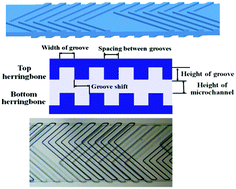A microfluidic chip with double-sided herringbone microstructures for enhanced capture of rare tumor cells†
Abstract
A microfluidic chip with single-sided herringbone microstructure has been developed to isolate circulating tumor cells (CTCs) from blood samples of cancer patients. Here, we describe a new double-sided herringbone chip in which staggered herringbone micromixers are placed on both top and bottom surfaces of microchannels. The double-sided herringbone structure enables a high CTC capture efficiency of whole blood samples without depletion of red blood cells because of the effects of leukocyte margination and plasma skimming. However, compared with the traditional single-sided herringbone chip, the double-sided herringbone chip has more complicated geometrical design, leading to a difficulty in experimental optimization of geometrical parameters. In this study, we developed an analytical model to geometrically optimize the herringbone chip by investigating the interactions between cells and antibody-immobilized device surfaces for enhancing CTC capture efficiency. On-chip cell capture experiments for validating modeling results were performed by spiking cultured EpCAM-positive tumor cells into blood samples from healthy donors. Based on the geometrical parameters optimized from the single-sided herringbone chip, the geometrically optimized double-sided herringbone chip enables a capture efficiency of 94 ± 4% of rare tumor cells directly from whole blood.



 Please wait while we load your content...
Please wait while we load your content...